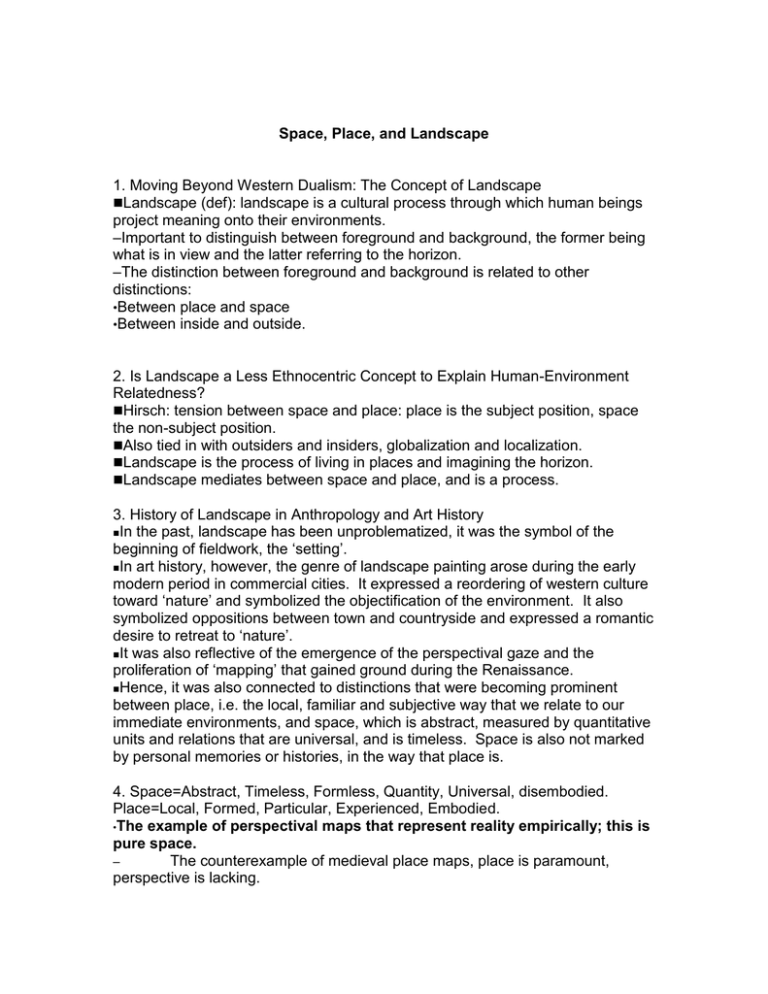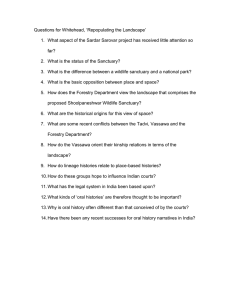1. Moving Beyond Western Dualism: The Concept of Landscape
advertisement

Space, Place, and Landscape 1. Moving Beyond Western Dualism: The Concept of Landscape Landscape (def): landscape is a cultural process through which human beings project meaning onto their environments. –Important to distinguish between foreground and background, the former being what is in view and the latter referring to the horizon. –The distinction between foreground and background is related to other distinctions: •Between place and space •Between inside and outside. 2. Is Landscape a Less Ethnocentric Concept to Explain Human-Environment Relatedness? Hirsch: tension between space and place: place is the subject position, space the non-subject position. Also tied in with outsiders and insiders, globalization and localization. Landscape is the process of living in places and imagining the horizon. Landscape mediates between space and place, and is a process. 3. History of Landscape in Anthropology and Art History In the past, landscape has been unproblematized, it was the symbol of the beginning of fieldwork, the ‘setting’. In art history, however, the genre of landscape painting arose during the early modern period in commercial cities. It expressed a reordering of western culture toward ‘nature’ and symbolized the objectification of the environment. It also symbolized oppositions between town and countryside and expressed a romantic desire to retreat to ‘nature’. It was also reflective of the emergence of the perspectival gaze and the proliferation of ‘mapping’ that gained ground during the Renaissance. Hence, it was also connected to distinctions that were becoming prominent between place, i.e. the local, familiar and subjective way that we relate to our immediate environments, and space, which is abstract, measured by quantitative units and relations that are universal, and is timeless. Space is also not marked by personal memories or histories, in the way that place is. 4. Space=Abstract, Timeless, Formless, Quantity, Universal, disembodied. Place=Local, Formed, Particular, Experienced, Embodied. •The example of perspectival maps that represent reality empirically; this is pure space. – The counterexample of medieval place maps, place is paramount, perspective is lacking. In the tradition of landscape painting: goal is to represent reality as empirically as possible. Space presupposes a point of view that is abstract and ‘objective’. 5. How Are Landscapes Constructed? Constitutive of social relations, cultural imagery, and power. There can be multiple constructions of landscape in a single society. Example: colonialism, mapping and naming. –Australia (Carter): The way in which Australia was settled and named was constitutive of the relationship between aboriginal Australians and European settlers. –Notion of the picturesque was also related to colonialism, as ‘other’ areas of the world became examples either of savagery or a romanticized Eden, a place of retreat. –Mapping and colonialism in India: the Topographical Survey in the 1800s was instituted to inventory the various geographic and geological resources of the Empire. •A visual appropriation of resources. 6. Non-Western Constructions of Landscape: I Landscape and Oral Memory: –Features of the landscape become devices for remembering and recounting shared histories. •Example: for the Wamirans of Papua New Guinea, their stones have multiple meanings: –They represent lineage histories and the lineages themselves; named clans are associated with stones. –They anchor houses and relations between people. –They signify specific events of importance. –The endow power, e.g. the rugby shirts and confer possession. –The appropriation of stones representing clan ancestors by the Catholic Church was seen as a way of asserting dominance and conversion. 7. Landscapes as Moral Lessons Fables and moral values can also be inscribed into landscapes: –Example, for the Wamirans, particular landscape features, e.g. the 3 mountains across the bay, embody mythic events that express key moral codes, i.e. the importance of reciprocity and hospitality and the way that social isolation is equated with poverty and lack of food. –The myths are inscribed into the landscape, surrounding people there with a sense of shared histories and a shared moral universe. 8. Landscape as Kinship In many small-scale, tribal societies, kinship is geography. Rights of access to land and resources are defined through kinship membership, rights and obligations. Rosaldo: local histories were related to lineage histories, which were, in turn, inscribed into the landscape. My own fieldwork among the Tadvi in central India: –Faliyas : Residence and descent groups. –Jambh or swidden cultivation: residence and migration –Moving and Naming: Descent and Place Names. •Every two to three generations, new forest land had to be cleared for cultivation. Sometimes clans, or faliyas, would shift their residence. Their former places of residence would be included as a sub-clan name. These sub-clan names would become important during marriage negotiations, ensuring that people from the same village, even several generations previously, did not marry. •The Tadvi are now using these oral histories, based on sub-clan names, to assert their rights to land possession.



